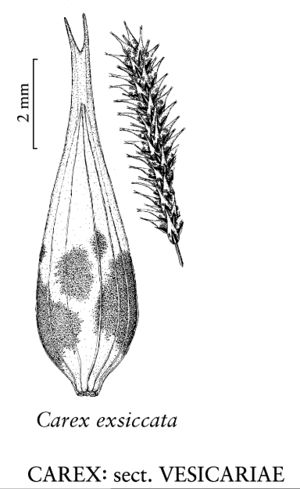Carex tuckermanii
Amer. J. Sci. Arts 49: 48, plate Ff, fig. 117. 1845.
Plants cespitose; rhizomes short or inconspicuous. Culms trigonous in cross-section, 40–120 cm, smooth distally. Leaves: basal sheaths reddish purple; ligules as wide to slightly longer than wide; blades dark green, flat to W-shaped, 2–5 mm wide, glabrous. Inflorescences 10–35 cm; proximal bract 25–70 cm, exceeding inflorescence; proximal (1–) 2–3 (–4) spikes pistillate, erect or the proximal spreading or pendent, cylindric; terminal 1–3 spikes staminate. Pistillate scales narrowly ovate, 3.9–5.2 × 1.2–2.4 mm, shorter than perigynia, margins entire, apex acute, awnless. Perigynia ascending, often green or straw colored, strongly 7–12-veined, veins running to beak, broadly elliptic, 7.5–12.5 × (4–) 4.5–7 mm, apex contracted; beak 2.4–4.8 mm, smooth, bidentate, teeth straight, 0.7–1.9 mm. Stigmas 3. Achenes brown, trigonous, asymmetric, deeply indented on 1 face, smooth.
Phenology: Fruiting Jun–Aug.
Habitat: Deciduous swamp forests, thickets, often along streams or pond shores, wet meadows
Elevation: 0–500 m
Distribution

N.B., Ont., Que., Conn., Ind., Maine, Md., Mich., Minn., N.Y., Ohio, Pa., Vt., Wis.
Discussion
Selected References
None.
Lower Taxa
"shortened" is not a number.
